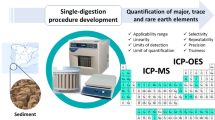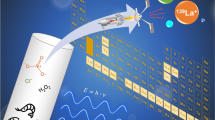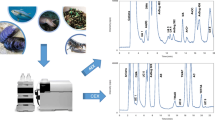Abstract
A consistent analytical method incorporating sulfuric acid (H2SO4) digestion and ICP-MS quantification has been developed for TiO2 quantification in biotic and abiotic environmentally relevant matrices. Sample digestion in H2SO4 at 110°C provided consistent results without using hydrofluoric acid or microwave digestion. Analysis of seven replicate samples for four matrices on each of 3 days produced Ti recoveries of 97% ± 2.5%, 91 % ± 4.0%, 94% ± 1.8%, and 73 % ± 2.6% (mean ± standard deviation) from water, fish tissue, periphyton, and sediment, respectively. The method demonstrated consistent performance in analysis of water collected over a 1 month.
Similar content being viewed by others

References
Almusallam AS, Abdulraheem YM, Shahat M, Korah P (2012) Aggregation behavior of titanium dioxide nanoparticles in aqueous environments. J Dispers Sci Technol 33(5):728–738
Cava-Montesinos P, Cervera ML, Pastor A, de la Guardia M (2005) Room temperature acid sonication ICP-MS multielemental analysis of milk. Anal Chim Acta 531(1):111–123
Chen X, Mao SS (2007) Titanium dioxide nanomaterials: synthesis, properties, modifications, and applications. Chem Rev 107(7):2891–2959
Diebold U (2003) The surface science of titanium dioxide. Surf Sci Rep 48(5–8):53–229
Dutschke F, Irrgeher J, Profrock D (2017) Optimisation of an extraction/leaching procedure for the characterisation and quantification of titanium dioxide (TiO2) nanoparticles in aquatic environments using SdFFF-ICP-MS and SEM-EDX analyse. Anal Methods 9:3626
Faucher S, Lespes G (2015) Quantification of titanium from TiO2 particles in biological tissue. J Trace Elem Med Biol 32:40–44
French RA, Jacobson AR, Kim B, Isley SL, Penn RL, Baveye PC (2009) Influence of ionic strength, pH, and cation valence on aggregation kinetics of titanium dioxide nanoparticles. Environ Sci Technol 43(5):1354–1359
Kang J, Okabe TH (2014) Production of titanium dioxide directly from titanium ore through selective chlorination using titanium tetrachloride. Mater Trans 55(3):591–598
Keller AA, McFerran S, Lazareva A, Suh S (2013) Global life cycle releases of engineered nanomaterials. J Nanopart Res 15(6):1–17
Kim W, Tachikawa T, Moon G-h, Majima T, Choi W (2014) Molecular-level understanding of the photocatalytic activity difference between anatase and rutile nanoparticles. Angew Chem Int Ed 53(51):14036–14041
Kim SH, Lim Y, Hwang E, Yim Y-H (2016) Development of an ID ICP-MS reference method for the determination of Cd, Hg and Pb in a cosmetic powder certified reference material. Anal Methods 8(4):796–804
Krystek P, Tentschert J, Nia Y et al (2014) Method development and inter-laboratory comparison about the determination of titanium from titanium dioxide nanoparticles in tissues by inductively coupled plasma mass spectrometry. Anal Bioanal Chem 406(16):3853–3861
Linsinger TPJ, Chaudhry Q, Dehalu V et al (2013) Validation of methods for the detection and quantification of engineered nanoparticles in food. Food Chem 138(2–3):1959–1966
Meyer DE, Curran MA, Gonzalez MA (2009) An examination of existing data for the industrial manufacture and use of nanocomponents and their role in the life cycle impact of nanoproducts. Environ Sci Technol 43(5):1256–1263
Mudunkotuwa IA, Anthony TR, Grassian VH, Peter TM (2016) Accurate quantification of TiO2 nanoparticles collected on air filters using a microwave-assisted acid digestion method. J Occup Environ Hyg 13(1):30–39
Mueller NC, Nowack B (2008) Exposure modeling of engineered nanoparticles in the environment. Environ Sci Technol 42(12):4447–4453
Myers WD, Ludden PA, Nayigihugu V, Hess BW (2004) Technical note: a procedure for the preparation and quantitative analysis of samples for titanium dioxide. J Anim Sci 82(1):179–183
Nations S, Wages M, Cañas JE, Maul J, Theodorakis C, Cobb GP (2011) Acute effects of Fe2O3, TiO2, ZnO and CuO nanomaterials on Xenopus laevis. Chemosphere 83(8):1053–1061
Robichaud CO, Uyar AE, Darby MR, Zucker LG, Wiesner MR (2009) Estimates of upper bounds and trends in nano-TiO2 production as a basis for exposure assessment. Environ Sci Technol 43(12):4227–4233
Rousis NI, Pasias IN, Thomaidis NS (2014) Attenuation of interference in collision/reaction cell inductively coupled plasma mass spectrometry, using helium and hydrogen as cell gases—application to multi-element analysis of mastic gum. Anal Methods 6(15):5899–5908
Rumpel C, Kögel-Knabner I, Bruhn F (2002) Vertical distribution, age, and chemical composition of organic carbon in two forest soils of different pedogenesis. Org Geochem 33(10):1131–1142
Schmid K, Riediker M (2008) Use of nanoparticles in swiss industry: a targeted survey. Environ Sci Technol 42(7):2253–2260
Schmidt J, Vogelsberger W (2006) Dissolution kinetics of titanium dioxide nanoparticles: the observation of an unusual kinetic size effect. J Phys Chem B 110(9):3955–3963
Shaw BJ, Ramsden CS, Turner A, Handy RD (2013) A simplified method for determining titanium from TiO2 nanoparticles in fish tissue with a concomitant multi-element analysis. Chemosphere 92(9):1136–1144. https://doi.org/10.1016/j.chemosphere.2013.01.065
Simonin M, Martins JMF, Uza G, Vince E, Richaume A (2016) Combined study of titanium dioxide nanoparticle transport and toxicity on microbial nitrifying communities under single and repeated exposures in soil columns. Environ Sci Technol 50:10693–10699
Tambach TJ, Veld H, Griffioen J (2009) Influence of HCl/HF treatment on organic matter in aquifer sediments: a Rock-Eval pyrolysis study. Appl Geochem 24(11):2144–2151
Tan SH, Horlick G (1986) Background spectral features in inductively coupled plasma/mass spectrometry. Appl Spectrosc 40(4):445–460
Weir A, Westerhoff P, Fabricius L, von Goetz N (2012) Titanium dioxide nanoparticles in food and personal care products. Environ Sci Technol 46(4):2242–2250
Zhang J, Wages M, Cox SB et al (2012) Effect of titanium dioxide nanomaterials and ultraviolet light coexposure on African clawed frogs (Xenopus laevis). Environ Toxicol Chem 31(1):176–183
Acknowledgements
The authors thank Jing Liu for laboratory assistance in preparing equipment and digests. The authors would also thank the Baylor Mass Spectrometry Center and the Baylor Center for Microscopy and Imaging for the use of instrumentation.
Funding
Funding was provided by the C. Gus Glasscock, Jr. Endowed Fund for Excellence in Environmental Science, Baylor University, the National Science Foundation (NSF) and the Environmental Protection Agency (EPA) under NSF Cooperative Agreement DBI-1266252, Center for the Environmental Implications of NanoTechnology (CEINT). Any opinions, findings, conclusions or recommendations expressed in this material are those of the author(s) and do not necessarily reflect the views of the NSF or the EPA.
Author information
Authors and Affiliations
Corresponding author
Rights and permissions
About this article
Cite this article
Watkins, P.S., Castellon, B.T., Tseng, C. et al. Validation of a Sulfuric Acid Digestion Method for Inductively Coupled Plasma Mass Spectrometry Quantification of TiO2 Nanoparticles. Bull Environ Contam Toxicol 100, 809–814 (2018). https://doi.org/10.1007/s00128-018-2336-2
Received:
Accepted:
Published:
Issue Date:
DOI: https://doi.org/10.1007/s00128-018-2336-2



